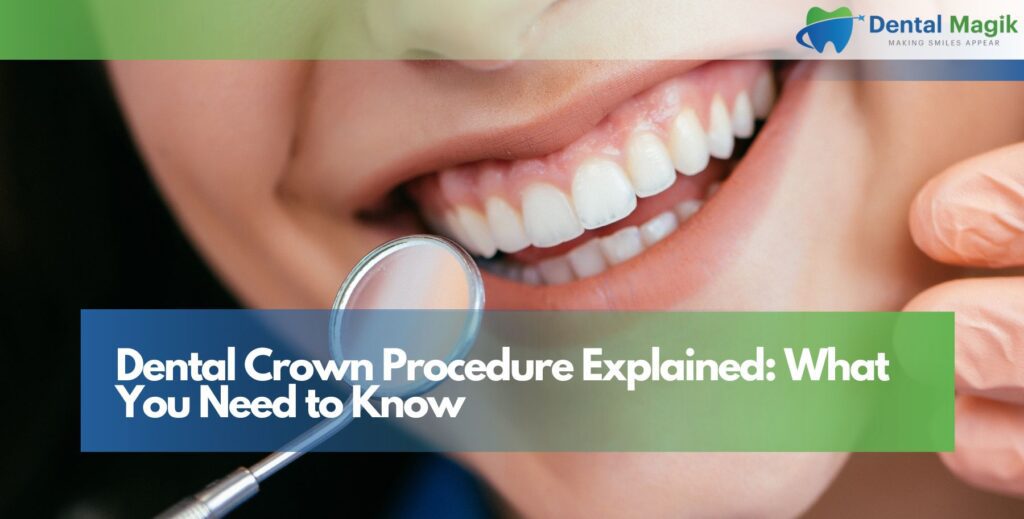If you’ve been told you need a dental crown, you might be feeling a little unsure about what to expect. Rest assured, you’re not alone. Dental crowns are one of the most common restorative treatments used to strengthen and restore damaged teeth. But what is the procedure really like, and is it painful? Let’s break it down in simple terms so you can feel informed and confident every step of the way.
In this comprehensive guide, we’ll walk you through the dental crown procedure, why it’s done, how it feels, what the recovery is like, and how long a crown can last. Whether you’re getting your first crown or replacing an old one, this article covers everything you need to know.
What Is a Dental Crown?
A dental crown is a custom-made cap that fits over a tooth. It covers the entire visible surface of the tooth, restoring its shape, size, strength, and appearance. Crowns are often used when a tooth is badly decayed, cracked, worn down, or after a root canal treatment.
Think of it as a protective shell—once it’s in place, it allows you to chew, smile, and speak normally again while preventing further damage.
When Is a Dental Crown Needed?
Not every damaged tooth needs a crown, but there are some situations where it’s the best solution:
- Large cavities that can’t be fixed with a filling alone
- Cracked or broken teeth that need structural support
- Worn-down teeth from grinding or erosion
- Root canal-treated teeth that need protection
- Cosmetic improvements for severely discolored or misshapen teeth
- Dental implants that require a crown as the visible tooth
Crowns can be made for both front and back teeth, depending on the type of damage and your individual case.
Types of Dental Crowns
Crowns can be made from a variety of materials, and your dentist will help you choose the best one based on the location of the tooth, your budget, and aesthetic goals.
Porcelain or Ceramic Crowns
These are popular for front teeth because they match the natural color of your enamel. They’re also metal-free and a good option for people with allergies.
Metal Crowns
Often made from gold or a base metal alloy, these are extremely durable and are best for molars that aren’t visible when you smile.
Porcelain-Fused-to-Metal (PFM) Crowns
These offer the strength of metal with the appearance of porcelain. However, the metal underneath may show slightly at the gum line over time.
Zirconia Crowns
Strong, long-lasting, and tooth-colored, zirconia crowns are becoming more common because they combine durability and aesthetics.
Step-by-Step: The Dental Crown Procedure
The process typically takes two appointments—though same-day crowns using digital technology may be an option at some practices.
Step 1: Consultation and Evaluation
Your dentist will begin by examining the tooth with X-rays to assess the extent of the damage. If the tooth can be saved and a crown is the right option, the procedure is planned.
Step 2: Tooth Preparation
Under local anesthesia, the tooth is reshaped to make room for the crown. This involves removing a portion of the enamel from all sides. If there’s a large portion missing, your dentist may build up the tooth with filling material first.
Step 3: Impressions
Next, your dentist takes an impression of your prepared tooth and the surrounding teeth. This mold is sent to a dental lab, where the custom crown is made. In some cases, digital scanning replaces the traditional mold.
Step 4: Temporary Crown Placement
While your permanent crown is being crafted, a temporary crown is placed to protect the tooth. It’s usually made of acrylic and is held in place with temporary cement.
Step 5: Crown Fitting and Final Cementation
Once the final crown is ready—usually in about 1 to 2 weeks—you’ll return for your second visit. Your dentist removes the temporary crown, cleans the tooth, and checks the fit and color of the new crown. Once everything is perfect, the crown is permanently cemented in place.
Is the Procedure Painful?
The actual procedure is generally painless thanks to local anesthesia. You may feel pressure or vibrations during the shaping process, but not pain. After the anesthesia wears off, mild sensitivity or soreness is common, especially around the gums. Over-the-counter pain relief usually works well.
What to Expect After Getting a Crown
It’s normal to experience:
- Sensitivity to hot or cold
- Mild gum irritation
- Discomfort when biting (if the crown is slightly high—your dentist can adjust it)
Caring for Your New Crown
You should treat your crown just like your natural teeth. That means:
- Brushing twice a day
- Flossing daily (gently around the crown)
- Avoiding sticky or super hard foods
- Using a nightguard if you grind your teeth
How Long Do Dental Crowns Last?
On average, a crown lasts 10 to 15 years, but with proper care, it can last even longer. Porcelain and zirconia crowns are strong but may chip if you bite something hard. Metal crowns tend to last the longest but aren’t as natural-looking.
Risks and Possible Complications
Dental crowns are a safe and routine treatment, but here are a few things to keep in mind:
- Crown feels loose: May need re-cementing
- Sensitivity doesn’t go away: Your dentist may need to adjust the bite or check for other issues
- Chipped porcelain: Small chips can be polished; large chips may require a new crown
- Crown falls off: Usually due to weak cement or damage—bring it to your dentist right away
Same-Day Crowns: Are They an Option?
Some dental offices offer same-day crowns using CAD/CAM technology. These crowns are designed and milled in the office while you wait, eliminating the need for a second appointment. While convenient, they may not be suitable for every case.
Cost of a Dental Crown
Prices vary depending on the material used, the dentist’s experience, and your location. On average, a crown can cost:
- Porcelain-fused-to-metal: $800 – $1,200
- All-ceramic: $1,000 – $1,500
- Gold or metal alloy: $1,200 – $2,000
- Zirconia: $1,200 – $1,800
Dental insurance may cover part of the cost if the crown is medically necessary.
Who Should Not Get a Crown?
While crowns work for most people, they may not be ideal if:
- The tooth is too badly damaged to support a crown
- Gum disease is active and untreated
- There isn’t enough tooth left even for build-up
In these cases, a dentist may recommend a different solution like extraction and implant.
Dental Crown vs Veneer: What’s the Difference?
Both improve the appearance of teeth, but their purpose and coverage differ:
- Crown: Covers the entire tooth; used for strength and protection
- Veneer: Only covers the front surface; used for cosmetic fixes
Your dentist will recommend the best option based on your needs.
Conclusion
Getting a dental crown may seem intimidating, but it’s a straightforward, effective treatment that restores both function and confidence. Whether your tooth is damaged, cracked, or weakened after a root canal, a crown is one of the best ways to protect it for years to come.
If you’re unsure whether you need a crown—or you want to discuss your options with someone you can trust—reach out to a skilled Dentist in East Brunswick for personalized care and expert guidance.







